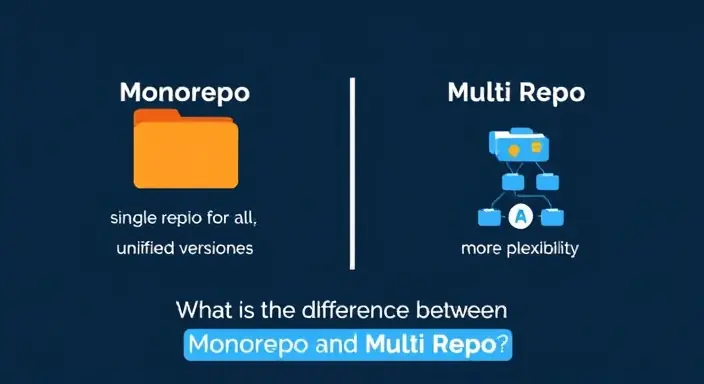Choosing between a single repository (monorepo) and multiple repositories (multi-repo) is key in DevOps. This choice greatly impacts your team’s efficiency and how smoothly things run. We’ll explore how these setups affect performance, scalability, security, and team communication in this article.
“The art of simplicity is a puzzle of complexity.” – Douglas Horton
Table of Contents
Simple Comparison
- Monorepo benefits include simplified dependency management and improved code sharing.
- Monorepo challenges involve increased complexity and higher risk impact of errors.
- Multi-repo benefits include reduced complexity and increased autonomy.
- Multi-repo challenges involve complicated dependency management and limited code sharing.
- Evaluating factors like codebase size and team structure is essential in choosing the right model.
Repositories in DevOps
In DevOps, repositories are key for teamwork and code management. It’s essential to understand what a repository is, learning its role in DevOps, and the tools used for managing it, will pave the way for success when working on projects.
What is a Repository?

A repository, or code repository, is a central spot for developers to keep their code. It helps with version control, tracking changes, and team collaboration. Systems like Github make these tasks easier with features like branching and merging.
Using a repository helps developers manage projects well. It ensures all changes are recorded and can be undone if needed. Whether it’s one big repository or many small ones, the choice affects how teams work together and manage projects.
The Role of Repositories in DevOps
Repositories are crucial in DevOps for continuous integration (CI) and continuous deployment (CD). They help teams automate testing, integration, and deployment, making work more efficient. Tasks include creating new branches, merging changes, and managing dependencies in separate repositories.
For example, using submodules helps manage dependencies between projects. This also lets teams set up pipelines for each repository, following project management best practices. Smaller repositories are easier to manage and integrate with CI/CD pipelines.
Common Tools and Platforms
Many tools and platforms are important for managing repositories in DevOps. GitHub, GitLab, and Bitbucket are top choices, each with unique features for teamwork and integration.
GitHub has tools for code review, issue tracking, and project management. It also works well with CI/CD tools for automated deployments. GitLab has similar features plus built-in CI/CD and project management tools.
Azure DevOps is another strong platform, supporting Github repositories and offering project management, CI/CD, and collaboration tools. It’s especially useful for large projects with its multi-repo checkout feature.
Picking the right repository platform is key to getting the most out of DevOps. Each platform has its own benefits that can greatly improve teamwork and efficiency.
What is the Differences between Monorepo and Multi Repo

A monorepo and a multirepo differ in how they organize and manage projects. A monorepo puts all projects in one place. This makes it easier to manage dependencies and build everything together, which helps software grow. But, as the codebase gets bigger, it can slow down.
A multirepo, on the other hand, splits each project into its own repository. This makes it easier to scale and manage different parts of an app separately. It also helps avoid big problems by keeping issues isolated. But, it can make it harder to manage dependencies and get everything to work together.
Let’s look at some main differences:
| Feature | Monorepo | Multirepo |
| Codebase Management | Unified repository for all projects | Separate repositories for each project |
| Collaboration | Encourages cross-project collaboration | Greater autonomy for individual teams |
| Dependency Handling | Simplified dependency management | Complex dependency integration |
| Scalability | May be challenging as the repository grows | Greater scalability for independent projects |
| Error Containment | High risk of large outages | Reduced error impact; isolated issues |
| Onboarding | Simplified onboarding with a centralized codebase | Varies by project; requires familiarity with multiple repos |
Big tech companies like Google, Facebook, and Microsoft use monorepos to help teams work together better. For example, a DevOps team working on a medium-sized app might find it hard at first. But, they can benefit from easier builds and shared dependencies.
On the other hand, a multirepo setup lets projects scale faster and use different tools. This is great for Infrastructure as Code (IaC) setups where files need special attention.
Choosing between monorepo and multirepo depends on your team and project needs. A DevOps course can help you understand and manage both setups well. Whether you’re working on a monorepo for better collaboration or a multirepo for scalability, picking the right strategy is crucial for success.
Pros and Cons of Mono Repo
The debate about using a Monorepo repository in DevOps is ongoing. A Mono repository can make workflows more efficient in many ways. However, it also has its own set of challenges. Let’s look at the good and bad sides, along with possible solutions.
Advantages
One big plus of a Monorepo benefit is better code reuse. Developers can share and reuse code across projects easily. This setup also makes teamwork smoother, as everyone works from the same place.
Another advantage is easier dependency management. With all dependencies in one place, it’s simpler to keep track and update them. This makes starting new projects quicker, letting developers get to work right away.
Disadvantages
However, there are downsides to using a Monorepo repository. One major issue is performance. As the repository grows, it can slow down, impacting work. There are also security risks, as a single point of failure if not managed well.
Scalability is another challenge. Handling a large and growing codebase in one repository needs better infrastructure and careful organization. Without it, the repository can become unmanageable.
How to Overcome
Fortunately, these problems can be solved. To improve performance, using modular structures within the repository can help manage size and complexity. Tools like Bazel can also help keep things running smoothly.
To keep things secure, setting up strict access controls and regular security checks are crucial. Using a mix of monorepo and multirepo strategies for different parts can also help with scalability.
A good DevOps course can teach teams how to make the most of a Monorepo repository. It helps automate pipelines and ensures smooth teamwork.
Pros and Cons of Multi Repo
Exploring a multi-repo strategy means looking at its good and bad sides. It can change how teams work, especially when they want to grow and work on their own. But, it also brings its own set of problems to manage.
Advantages
The main plus of using multiple repositories is the multi repo flexibility it offers. Teams can work on different projects without getting in each other’s way. This setup helps teams work better on their own, without interference. It also works well with different technologies, which is great for complex projects.
Disadvantages
However, there are downsides to using multiple repositories. Managing links between them and keeping everything in sync can be hard. There’s also a risk of code being copied, which can lead to problems later on. Plus, keeping track of changes across many places can be overwhelming.
How to Overcome
Using the right tools and methods can help deal with the issues of multiple repositories. Setting up good CI/CD pipelines is key to keeping everything running smoothly. Package managers like npm or Yarn help manage links between projects. Clear plans and ways to keep track of changes are also important. Good communication among team members helps when working on projects that involve many repositories.
In summary, while a multi-repo strategy brings a lot of benefits like multi repo flexibility and autonomous development, it needs careful planning and the right tools. By using the best practices and technology, organizations can enjoy the benefits while handling the challenges of repository scalability.
Who Typically Works with a Monorepo Repo vs Multiplerepo
It’s key to know who works with Monorepo or multiple repositories. This helps teams work better together and aligns roles in DevOps. We’ll see how different roles use these repositories and how it affects their work.
Cloud Architect
Cloud Architects often use Monorepo repositories to manage infrastructure as code (IaC). A Monorepo keeps configurations and scripts in one place, making updates easier and collaboration smoother. This approach ensures consistency and simplifies managing cloud resources across platforms like AWS and Azure.
To excel in this role, professionals can benefit from the cloud architect masters program offered by AVC. This program provides training on AWS, Microsoft Azure, and Google Cloud Platform (GCP), with hands-on labs and real-world projects. Participants learn essential skills like cloud architecture design, security, and cost management, preparing them to handle both Monorepo and multiple repo setups effectively.
CI/CD Engineer
CI/CD Engineers focus on automating pipelines and making deployments smooth. They might choose multiple repositories to set up specific pipelines for different projects. This lets them manage releases and deployments for each project separately.
This approach makes it easier to handle build and deployment tasks. CI/CD Engineers can then focus on improving their pipelines.
Software Developer
Software Developers can work with either Monorepo or multiple repositories. It depends on the project’s size and complexity. In a Monorepo repository, developers can share code and track changes together, which helps teamwork.
On the other hand, using multiple repositories is good for projects with many parts. It lets developers work on different parts without getting in each other’s way. This makes it easier to handle dependencies and focus on specific tasks.
DevOps Engineer
DevOps Engineers are key in using both Monorepo and multi-repo models. They choose based on what’s best for workflow, scalability, and performance. For small, simple projects, a Monorepo repository is often better because it keeps everything together.
But for big, complex projects, multiple repositories are better. They allow for a modular setup and let teams work independently. DevOps Engineers make sure the chosen model fits the company’s deployment strategy.
Taking a DevOps course from AVC can help teams effectively manage workflows, which is crucial for success with both Monorepo and multiple repository setups. As teams expand and projects evolve, choosing the right strategy becomes essential for seamless collaboration and efficient delivery.
When to Use Monorepo vs Multi Repo for DevOps
Google’s monorepo is a prime example. It held 86 terabytes of data, 2 billion lines of code, and 9 million source files in 2015. This shows how a monorepo can be a single source of truth, making dependency management easier.
On the other hand, multi repo systems give teams more freedom. They can work on different parts of a project without interference. GitHub and BitBucket manage repositories differently, with GitHub offering more organizational tools.
The development environment also plays a big role in this decision. Monorepos promote teamwork, especially for changes across projects. But, multi repos can speed up releases by handling services separately. Companies like Amazon, Netflix, and Uber use microservices for this reason.
Monorepo vs Multi Repo: Which is Better for DevOps?
Choosing between a Monorepo or a multi repo for DevOps depends on your project’s needs and your team’s goals. It’s key to understand these factors for DevOps optimization and better team efficiency.
Mono repo setups, like those at Google and Facebook, bring many benefits. They increase visibility and make teamwork easier. This is great for teams that want to work together well and make changes smoothly. But, it needs careful planning to avoid problems.
On the other hand, multi repo setups are better when you need to work on different parts separately. They help avoid problems when updating different parts of the code. This makes CI/CD work better. But, they can make communication and teamwork harder.
A study on medium showed both types have challenges. So, picking the right one depends on your business size and needs. Big companies like Google use Mono repos for a unified codebase. But, companies with many parts might do better with multi repos and tools like Lerna.
Optimizing DevOps Success with The Right Repo Model
Understanding repository management is key for DevOps success. Your team might choose one big repository for everything or many small ones for different projects. Either way, managing your repositories well is crucial. A 2020 survey found that 99% of teams saw positive changes after adopting DevOps, showing the importance of the right model.
Top DevOps teams, as shown in a 2019 study, release software much more often and quickly. They also have much fewer failures. This shows how good repository management leads to better teamwork and faster updates.
Cloud experts and DevOps teams always look to improve their methods. They choose between one big repository or many small ones based on what’s best for their team. They also use tools to track and manage their systems. By always trying to get better and managing their repositories well, teams can work better together, update faster, and innovate more.
Monorepo vs Multirepo FAQ
What roles do repositories play in DevOps?
Repositories help manage code changes and track progress. They make it easier to work together and integrate with other tools. This leads to better project management and deployment processes.
What are some common tools and platforms used for repositories?
GitHub, GitLab, and Bitbucket are popular for hosting repositories. They offer features for teamwork and integration with DevOps tools.
What is the difference between Monorepo and Multi Repo?
Mono Repo, or monorepo, holds all projects in one place. This simplifies managing dependencies and builds. Multi Repo, or polyrepo, splits projects into separate repositories. This boosts modularity but makes managing dependencies harder.
What are the advantages of using a Mono repo?
Mono Repos streamline project management and make coordinating dependencies easier. They offer a unified development environment with consolidated builds. This can make workflows more efficient and reduce overhead.
What are the advantages of using a Multi Repo?
Multi Repos give teams more freedom to work independently. This can speed up development and improve project modularity and scalability.
Which repository strategy is better for DevOps?
The choice between Monorepo and Multi Repo depends on project needs and goals.onorepo Repo is good for coordinated efforts, while Multi Repo suits independent operations.
How can we optimize DevOps success with the right repository model?
Understanding trade-offs and aligning with goals is key. Adjusting the repository model as needed can improve collaboration, speed up deployments, and boost innovation.

Pradeep Sharma is a author the mind behind Techjustify, where I craft insightful blogs on technology, digital tools, gaming, AI, and beyond. With years of experience in digital marketing and a passion for tech innovation, I aim to simplify complex topics for readers worldwide.
My mission is to empower individuals with practical knowledge and up-to-date insights, helping them make informed decisions in the ever-evolving digital landscape.




